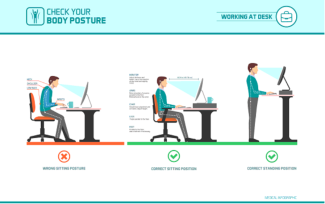
Avoiding the Side Effects of Inactivity
Prolonged sitting/sedentary lifestyle is unfortunately quite commonplace in our modern society. Technology innovation and convenience, job requirements, and lack of motivation are several factors that can lead to inactivity. The World Health Organization (WHO) has associated a sedentary lifestyle with increased risk of cardiovascular disease, obesity, diabetes, cancer, anxiety/depression, and an increase in all causes of mortality. In addition to negative effects on physiological and mental well-being, being sedentary can have disastrous effects on our musculoskeletal health. Research has associated prolonged sitting with an increase in neck, thoracic spine (mid back), shoulder, and lumbar spine (low back) pain.
This topic is especially important given the current landscape of the global COVID-19 pandemic. Many of us are working from home, sitting more than usual, not preforming our usual workout routine, or simply not moving enough. Because of this, many are finding themselves feeling stiffer than usual and are noticing new or recurring aches and pains that will not subside. There are several things that can be done at home with little to no equipment that will help alleviate the stress placed on our bodies from being sedentary.
Start moving! Take the dog for a walk, go for a bike ride, try some yoga, dust off that elliptical. However you do it, start moving. The American College of Sports Medicine (ACSM) states the health-related benefit of exercise include cardiorespiratory endurance, body composition, muscular strength, muscular endurance, and flexibility. The following are the ACSM’s physical activity recommendations for healthy adults:
- Moderate intensity aerobic activity for a minimum of 30 min 5 days/week or
- Vigorous intensity aerobic exercise for a minimum of 20 min 3 days/week
- Moderate intensity aerobic exercise can be broken into 10 min bouts
- Activities for muscular strength and endurance a minimum of 2 days/week
For those that find themselves sitting for extended periods while working, simple modifications can be made to your workstation. By doing so, we can begin to decrease the stress placed on our bodies from prolonged sitting. Try the following changes and adjust to your comfort level:
Desk: ensure there is adequate room for your thighs to fit under the desk surface. If the desk is too high, raise the chair and use a footrest if needed.
Chair: your back should be supported by the backrest by allowing natural curve in your spine. Ensure you are sitting upright to avoid slouching. Hips should be slightly higher than your knees, use a seat pad if needed.
Keyboard and Mouse: should be on the same level. While typing or using the mouse, your hands should be positioned at or below the level of your elbows. Ensure your elbows are close to your body and not flared out to the side.
Monitor: should be positioned directly behind the keyboard and at arm’s length away. The top of the screen should be slightly below eye level and tilted
Telephone: if talking and writing/typing, utilize a headset rather than cradling the phone between your ear and shoulder.
Another way we can combat the aches and pains associated with a sedentary lifestyle is to reverse the posture that we find ourselves in throughout the day. By placing our body in a static posture for extended periods of time we create imbalances with some areas becoming tight and others becoming overstretched. Please visit the link below for some general stretches to perform throughout the day when sitting for long periods. If you experience any type of pain or would like additional information, please contact your local Doctor of Physical Therapy for further assessment and recommendations. Remember, physical therapists improve the way you move!
Disclaimer: the above are merely suggestions and not intended to be taken as medical advice. If you experience pain with any of the above, stop immediately and contact your local orthopedic physical therapist for a full assessment and treatment.
Ryan Hastie, PT, DPT, CSCS
Doctor of Physical Therapy
Certified Strength and Conditioning Specialist
Titleist Performance Institute Medical 2 Certified

